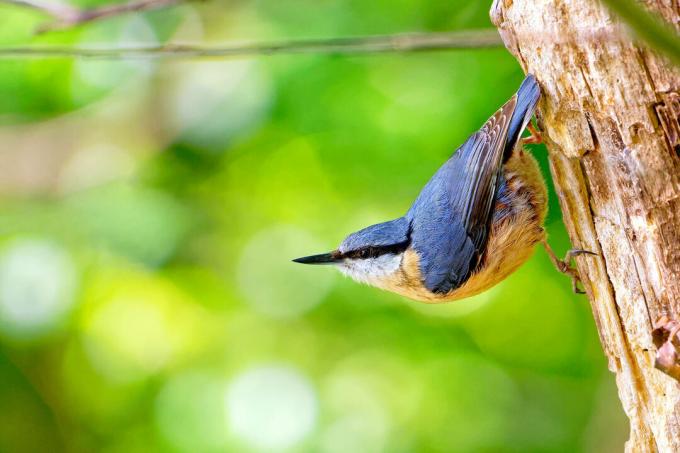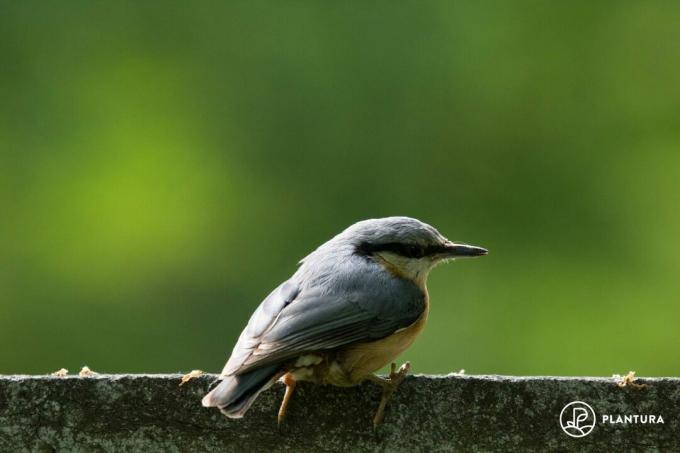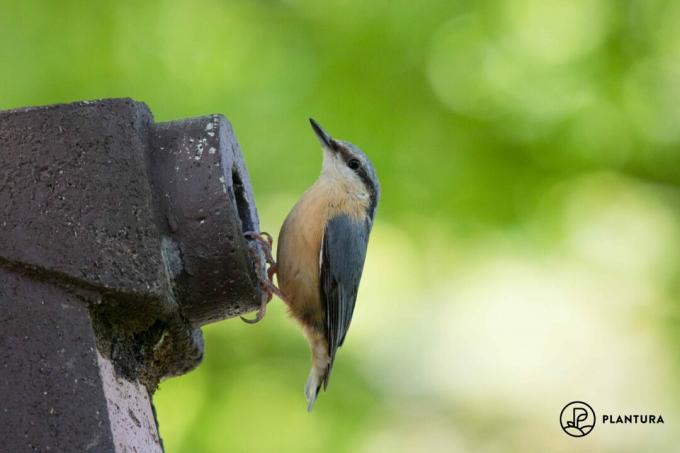What does the nuthatch look like? When does it breed and what does it eat? Our profile tells you everything you should know about the nuthatch.

The nuthatch (Sitta europaea) is a very interesting contemporary with many special properties. It is therefore no wonder that it was named "Bird of the Year" in 2006. The nuthatch can often be seen on tree trunks and branches, where it moves nimbly to peck insects from crevices of bark. In this behavior it is similar to the treecreeper, but in contrast to this - and to many other birds - the nuthatch can not only climb up the tree, but also climb it upside down. It also combines other properties of other species: Thanks to the combination of a tit-like shape and a powerful beak, the is used to open seeds and nuts with loud, woodpecker-like knocking, the nuthatch is also nicknamed "woodpecker tit" known. You can find more information about size, song and habitat here in our Kleiber profile.
contents
- Wanted poster of the Kleiber
-
This is how you recognize the nuthatch
- How does the song of the Kleiber sound?
- How do you recognize the young birds?
- How do you recognize the eggs of the glue?
- How do you differentiate between female and male nuthatches?
- What is the ideal habitat of the glue?
- Where does the nuthatch build its nest?
- When is the nuthatch breeding season?
- What do nuthatches do in winter?
-
This is how you can support the nuthatch
- What do nuthatches eat?
- Which nesting boxes are suitable for nuthatches?
- How can you give Kleiber additional support?
Wanted poster of the Kleiber
| size | Up to 14 cm |
| weight | Up to 20 g |
| Breeding season | April May |
| lifespan | Up to 7 years |
| habitat | Forests, parks, woods, large and wild gardens |
| Feed preference | Insects, spiders, nuts and seeds |
| Threats | Dwindling nesting and food supply |
This is how you recognize the nuthatch
A nuthatch is about the size of one Great tit and of a similar stature - except for the long, pointed beak. Its back and the wing covers are colored blue-gray and are in contrast to its light, brownish-red belly. Like an extension of the dark beak, a black eye stripe, which is underlined by white cheeks, extends to the base of the wings.

How does the song of the Kleiber sound?
To miss a nuthatch is almost impossible. Its piercing bird's voice resounds loudly through the forest. In addition to numerous calls, ranging from sharp whistles to trills, the nuthatch possesses a chant consisting of a stanza of rising or falling clear sounds: "Wih-wih-wih".
The song of the Kleiber sounds like this:

How do you recognize the young birds?
The young birds of the nuthatches are easy to recognize because they already look very similar to the adult animals. The eye stripe is not quite as dark and the belly less reddish, but overall a young nuthatch can already be identified without any doubt.

How do you recognize the eggs of the glue?
The nuthatch lays six or seven eggs per nest. These are about two centimeters tall, white and covered with reddish spots. The eggs are laid in the brood cavity on a base made of bits of bark, grass and feathers. The bark flakes of the Scots pine are often used for this, although this rarely occurs near the nesting site.
How do you differentiate between female and male nuthatches?
Female nuthatches differ only slightly from their male counterparts. The typical distinguishing feature here are the chestnut-brown flanks typical of the males, which are only colored in the same light brown-red as the belly in the females.
What is the ideal habitat of the glue?
The ideal habitat for the nuthatch consists of a deciduous or mixed forest. However, the songbird also feels at home in a human environment - as long as there is sufficient old trees available. These include parks, avenues and also large, wild gardens.
Where does the nuthatch build its nest?
As a cave breeder, the nuthatch is dependent on old trees with natural tree hollows. Old woodpecker holes are also very often used and “renovated”, because the nuthatch closes its own to protect against nest predators Cave entrance so wide that it just barely fits through, with the help of clay and small lumps of earth that surround the opening knocks down. This process is also known as "gluing", which means "gluing" and gave the nuthatch its name.

When is the nuthatch breeding season?
Nuthatch females lay their eggs between mid and late April. The young birds hatch after about two weeks of breeding and are then fed by both parents with lots of insects. After about 24 days they leave the nest and make their first attempts at flight. At this stage they are particularly susceptible to predators such as corvids or birds of prey. A second brood very rarely follows.
What do nuthatches do in winter?
Nuthatches can be observed all year round in Germany and the breeding pairs stay together in their territories even in winter. There they set up a large number of hiding places in the late year, in which they collect nuts, acorns and beechnuts, so that they can secure their supplies in the cold winter months. The supplies are hidden in cracks in the trees, camouflaged with lichen or moss and vehemently defended.
This is how you can support the nuthatch
Although nuthatches are quite capable of looking after themselves in winter, there are many small measures that can make life easier for the native birds. Nuthatches still have a stable population in Germany, but due to the low proportion of deciduous and mixed forests, they lack natural habitat. By offering additional food or nesting boxes, you can support the animals and make a new home possible in your own garden.
What do nuthatches eat?
In summer, nuthatches mainly feed on insects and spiders, which they peck out of the bark with their pointed beak along tree trunks and branches. In winter, however, they are vegetarian and rely on nuts and seeds. If you want to feed in winter, you should therefore Fatty food or use pure nuts, for example peanuts. But sunflower seeds are also an energy-rich treat for nuthatches. Our Plantura Sunflower seeds for wild birds are ideal for winter feeding, for example - they come without a shell and are therefore easy for the birds to pick up. It also reduces waste at the feeding station, in the garden or on the balcony.
Tip: You can find valuable information on the design, cleaning and positioning of a suitable feeding place in our article "Build bird feeder yourself“.
Which nesting boxes are suitable for nuthatches?
As cave breeders, nuthatches prefer completely closed nesting boxes with an entrance hole with a diameter of 32 millimeters. However, since nuthatches have a habit of making their burrow openings smaller, they may also occupy nesting boxes that are actually intended for larger birds.
Tip: In our special article on the subject, we have compiled a number of important information that you should consider when buying or Construction of a nest box as well as when installing and maintaining it.

How can you give Kleiber additional support?
Anyone who advocates the protection of oak and beech forests also secures the natural habitat of the Kleiber. Unfortunately, there is a continuous decline in these old trees, which is also threatening many other animal species. In addition to the nesting opportunities, the food supply is also dwindling due to the death of insects. It is therefore advisable to avoid chemical sprays as much as possible, which are partly to blame for this decline. If you also want to bring a little more life into your garden, you can use our Plantura beneficial insect magnet create a paradise for a large number of insects, which of course also benefits the feathered garden visitors.
More tips for designing a insect-friendly gardenthat is about not only the nuthatch, but also robin, jay and Co. can be found here.



